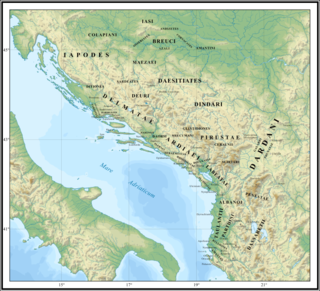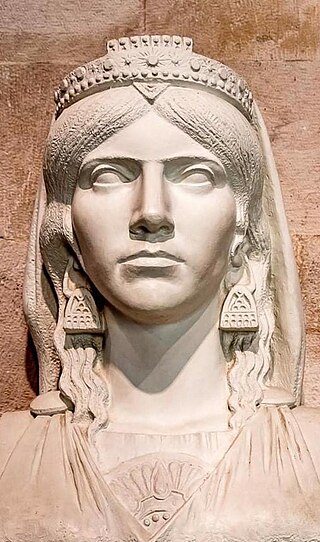Related Research Articles

The Illyrians were a group of Indo-European-speaking peoples who inhabited the western Balkan Peninsula in ancient times. They constituted one of the three main Paleo-Balkan populations, along with the Thracians and Greeks.
Agron was an Illyrian king of the Ardiaean Kingdom in the 3rd century BC, ruling c. 250–231 BC. The son of Pleuratus II, Agron succeeded in reconquering southern Illyria, which had been under the control of Epirus since the time of Pyrrhus, and in extending Illyrian rule over many cities in the Adriatic region, including Corcyra, Epidamnos, and Pharos.
Triteuta was an Illyrian queen and the first wife of the Illyrian king Agron of the Ardiaei, with whom she had a son named Pinnes.
Taulantii or Taulantians were an Illyrian people that lived on the Adriatic coast of southern Illyria. They dominated at various times much of the plain between the rivers Drin (Drilon) and Vjosa (Aoös). Their central area was the hinterland of Epidamnos-Dyrrhachion, corresponding to present-day Tirana and the region between the valleys of Mat and Shkumbin (Genusus). The Taulantii are among the oldest attested Illyrian peoples, who established a powerful kingdom in southern Illyria. They are among the peoples who most marked Illyrian history, and thus found their place in the numerous works of historians in classical antiquity.

Sveti Ivan Zelina is a town in Zagreb County, Croatia.
The Ardiaei were an Illyrian people who resided in the territory of present-day Albania, Kosovo, Montenegro, Bosnia and Herzegovina, and Croatia between the Adriatic coast on the south, Konjic on the north, along the Neretva river and its right bank on the west, and extending to Lake Shkodra to the southeast. From the 3rd century BC to 168 BC the capital cities of the Ardiaean State were Rhizon and Scodra.
Dimale or Dimallum was a town in southern Illyria in classical antiquity which was situated in the vicinity or within the territory of the Parthini, an Illyrian tribe. It was built on a hill of 450 m above sea level, in the hinterland of Apollonia, about 30 km from the eastern coast of the Adriatic. It is located in today Krotinë, Berat County, Albania.
The Parthini, Partini or Partheni were an Illyrian tribe that lived in the inlands of southern Illyria. They likely were located in the Shkumbin valley controlling the important route between the Adriatic Sea and Macedonia, which corresponded to the Via Egnatia of Roman times. Consequently, their neighbours to the west were the Taulantii and to the east the Dassaretii in the region of Lychnidus.
Mytilos or Mytilus was an Illyrian king who reigned in southern Illyria, around the hinterland of Dyrrhachion and Apollonia. He was the successor of Monunios, and probably his son. Mytilus is mentioned by Pompeius Trogus and Frontinus reporting the events of the military conflict between the Illyrians and the Epirotes under Alexander II, son of Pyrrhus. From around 270 BC Mytilus minted in Dyrrhachion his own bronze coins bearing the king's name and the symbol of the city.

The Bylliones were an Illyrian tribe that lived near the Adriatic coast of southern Illyria, on the lower valley of the Vjosa river, in the hinterland of Apollonia. The Bylliones were firstly attested in epigraphic material from the oracle of Dodona dating back to the 4th century BC, and their koinon was firstly attested in a 3rd-century BC inscription from the same oracle. Their territory was trapezoidal on the right side of the rivers Luftinje and Vjosa, extending in the west to the Mallakastra mountains. The chief city of their koinon was Byllis. Another important centre of their koinon was Klos, an earlier Illyrian settlement later called Nikaia, as an inscription attests. The Bylliones also inhabited in the area of an ancient sanctuary of the eternal fire called Nymphaion.

The Illyrian Kingdom is the name of a country that existed on the Western part of the Balkan Peninsula in ancient times and represented an alliance of Illyrian tribes that was under the rulership of a single leader, expressly referred to as "King of the Illyrians" in ancient historical records.

The Labeatae, Labeatai or Labeates were an Illyrian people that lived on the Adriatic coast of southern Illyria, between modern Albania and Montenegro, around Lake Scodra.
The Enchelei were an ancient people that lived around the River Drin and the region of Lake Shkodra and Lake Ohrid, in modern-day Albania, Montenegro, and North Macedonia. They are one of the oldest known peoples of the eastern shore of the Adriatic Sea. In ancient sources they sometimes appear as an ethnic group distinct from the Illyrians, but they are mostly mentioned as one of the Illyrian tribes. They held a central position in the earlier phase of Illyrian history. In ancient Greek literature they are linked with the end of the mythical narrative of Cadmus and Harmonia, a tradition deeply rooted among the Illyrian peoples.
Kokošiće is a village in the municipality of Sjenica, Serbia. According to the 2002 census, the village has a population of 124 people.
Pleuratus II was an Illyrian king of the Ardiaean Kingdom.

Teuta was the queen regent of the Ardiaei tribe in Illyria, who reigned approximately from 231 BC to 228/227 BC.
Yantarny, Yantarnaya, or Yantarnoye is the name of several inhabited localities in Russia.
References
Illyrian Language- The Cambridge Ancient History
45°08′N17°15′E / 45.133°N 17.250°E